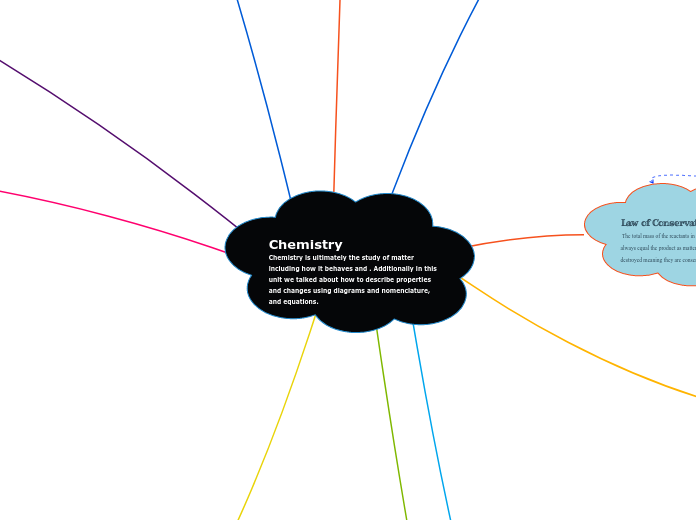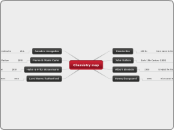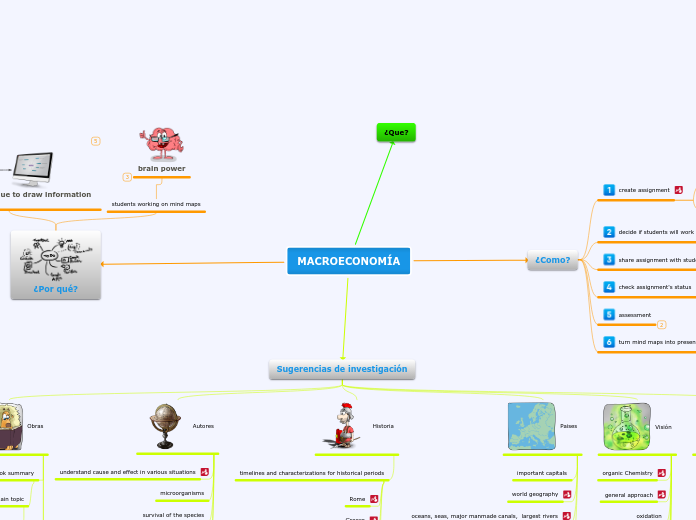What is a Chemical Reaction?
A process where two or more substances react to produce a new substance with new properties
Chemistry
Chemistry is ultimately the study of matter including how it behaves and . Additionally in this unit we talked about how to describe properties and changes using diagrams and nomenclature, and equations.
Types of chemical reactions
Combustion
When hydrocarbon reacts with oxygen causing it to “burn”; there are two types of combustion which are sorted based on the amount of oxygen present
Incomplete Combustion
A reaction in which limited oxygen is present which
produces water, carbon dioxide, soot (C(s)),
carbon monoxide, and water vapor
Complete Combustion
Adequate or excess oxygen is present in reaction and it
yields carbon dioxide and water vapor
Decomposition
A (complex) compound breaks down into 2 or more (simpler) products
Synthesis
2 or more reactants combining to form one [complexer] product
Single Displacement
One metal OR one non-metal(in it's elemental state)
displaces\switches spots with another metal OR
non-metal which is a part of a compound
a
Neutralization
A special type of double displacement reaction
that involves an acid and a base reacting which
yields water and an ionic compound/salt
pH Scale
Acidic
A substance is considered acidic if it has a pH level of less than 7;
the lower the pH level the more acidic a substance is
Basic
A solution is considered basic
when it has a pH level of 8 or higher
Neutral
A solution with equal concentration of hydronium and hydroxide ions (with a pH level of 7)
pH scale
It's a going from 1-14 scale used to compare the acidity of solutions
*Note a pH scale is logarthmic meaning one substance is 10x more acidic as the one before (from 14-1) (e.g Lemon juice is 1000x more acidic than coffee)
pH
A measure of how acidic or basic a solution which is
based off the concentration of hydroxide ions and hydronium ions released when the substance is dissolved in water
If there is a higher concentration of hydroxide the solution is basic and if there's a higher concentration on hydronium ion (H+) the solution is acidic
Acids & Bases
For a compound to be considered an acid or base it must be in a aqueous state (Aqueous(aq) it means the compound is dissolved in water )
Acids
An acid is a compound that produces a hydrogen ion (specifically the hydronium ion H+) when aqueous (released into water) therefore all acids have hydrogen as they need hydrogen to produce the ion
Properties of Acids:
-Has pH of less than 7
-Tastes sour
-Good conductor
-Strong acids are highly corrosive
-Release hydonium ions when dissolved in water
Types of Acids
Oxyacids
Oxyacids must contain oxygen, hydrogen and another element
Binary Acids
Binary Acids are composed of hydrogen and one other element typically a non-metal
Base
Bases are compounds which produce a hydroxide ion when aqueous (disolved in water) and are usually composed of hydroxide (OH) and a metal
Properties of a Base:
-Has pH of more tthan 7
-Tastes bitter
-Good conductor
-Strong bases are highy corrosive
-Release hydroxide ions when dissoved in water
Octet Rule
Atoms are always trying to stabilize by filling their valence shell by attaining 8 electrons (except hydrogen, helium, and lithium which only need two electrons) by getting or losing electrons. Elements (not including transitional metals) in main groups 1-3 lose electrons and 5-7 gain electrons (some groups lose electrons as it requires less energy to acheive stability that way)
Ions
Ions are charged atoms; atoms try to have a full outer orbital therefore when they gain or lose electrons which causes an imbalance of protons and electrons thus losing its neutral state, forming ions
(Image to Left:Lewis Dot Diagrams for Ions)
Anion
Negatively charged ions meaning there are more electrons than protons (typically nonmetals)
Cations
Positively charged ions meaning they have more protons than electron (and are typically metals)
Compounds
A compound is a substance formed of 2 or more elements in a SPECIFIC ratio
Types of Compounds
Ionic Compound
Any compound composed of a metal and non-metal (cation + anion). Essentially,“excess” electrons on the valence shell preventing a cation from being stable is transferred to anions to allow both atoms to have a stable octet and create an ionic bond
(Image to left: Lewis Dot Structures for potassium oxide)
Molecular/Covalant Compounds
Molecular compounds are compounds formed of 2 or more non-metals which share valence electrons (and there energy) to attain a stable octet thus creating a covalent bond
Polyatomic Ions
An ion which is formed from two or more atoms but act like a single particles (therefore in a compound the polyatomic acts like a non-metal (except ammonium) in an compound however you do not add -ide to the end)
Diagrams
Lewis Dot Diagrams/Structures
A diagram where the chemical symbol representing the atom is written in the middle and dots are drawn around the symbol to represent the number of valence electrons (which be used to show the energy level and bondings of an atom or a compound)
*More Lewis Dot Diagrams are situated under ions, iomic compounds, and molecular compounds
Bohr-Rutheford Diagrams
*Not usesd as much as Lewis diagrams to show bondings or elements after calcium (#20) as it can get very crowded/messy
Physical & Chemical
Properties & Changes
Properties
Essentially, observations
which can be used to identify
a substance
Chemical Property
A characteristic which describes the way a given substance interacts with anther substance
Examples
-Combustibility
-Reactivity
-Acidity
Physical Property
A characteristic which can be observed without causing a chemical reaction and can typically be observed with your senses
Examples
-Odor
-Texture
-Viscosity
-Ductility
-Boiling/melting point
Types of Changes
Chemical Change
An irreversible or difficult to reverse change
that alters the chemical composition of a
given substance which is evident as new
substances and/or properties are formed
(ex oxidizatin of iron)
Indicators of Chemical Change
-Bubbles are present indicating a new gas is formed
-Change in color
-A solid is formed by 2 liquids called a percipitate
-Heat and/or light is absorbed or produced
Physical Change
An easily reversible change in which
ONLY the state and/or appearance
changes and chemical composition remains
unchanged
(ex. Liquid water freezing to become ice)
Describing Chemical Reactions
Reactants =Substances on the left-side of the arrow you start the reaction with
Products=Substances on the right-side of the arrow which are the chemicals produced during the reaction
Word Equation
Describes chemical reactions using the full names of reactants and products
Chemical Equations
Chemical symbols/formulas are used to describe chemicals (reactants and products) involved in the reaction
(an abreveation of the state may also be included in the subscipt)
Skeleton Chemical Equation
Chemical symbols/formulas are used to describe chemicals (reactants and products) involved in the reaction
(an abreveation of the state may also be included in the subscipt)
*Refer to image under main idea
Balanced Chemical Equations
A specific type of chemical equation where, both sides of the arrow must have the same amount of each type of atom and in order to acheive that one must use coeffcients (tchart method is commonly used to balance equations as seen )
Law of Conservation of Mass
The total mass of the reactants in a chemical reaction will always equal the product as matter (atoms) can't be created or destroyed meaning they are conserved and rearranged only
Nomenclature
(Naming Chemical Compounds)
Naming Bases
Naming process is similar to ionic compounds as bases are oftens a cation (metal) plus hydroxide which is an anion
Formula->Name
As bases are often ionic compounds, you would first write the name of the appropriate metal then you would write hydroxide (it's important to indicate the compound is aqueous or else it's not a base)
Name->Formula
Identify the metal and the hydroxide ion (as the non-metal) then write down their chemical symbols and find their charges and apply crossover method (similar to ionic compounds) and in the subscript include "aq" in brackets to indicate the compound is a base
Naming Acids
Naming Binary acids
Naming Oxyacids
Similar to binary acids, however you omit the "hydro" and begin with the root word of the element (which is not hydrogen or oxygen) and add "ic" then write acid
*Note
Oxyacids are formed of polyatomic ions which have multiple derivatives and each deravitive has it's own ending "ic" is for acids with the base polyatomic ion
Base + one oxygen (has prefix and suffix per...ic)
Base - one oxygen (ending is -ous)
Base - 2 oxygen (hypo...ous)
*in place of dots place the root of the non-oxygen element
Naming Ionic Compounds
Name -> Formula
Write chemical symbols for elements then ionic charges (from P.T) on top and crossover the charge numbers so they become the subscript and simplify these numbers if necessary
Formula -> Name
Write metal name + non-metal root + “-ide” gives chemical name
*Note for multivalent elements you must determine the charge by using the process below and checking if both mean the same
Naming Covalent/Molecular Compounds
Name -> Formula
Molecular compounds have prefixes indicating how many of each atom they have and the root tells you the name of the elements used; find the corresponding symbols used to form the compound and apply subscript according to prefix
(*Note you DO NOT crossover the charges or subscripts)
Formula -> Name
Write appropriate prefix of first element using subscript then chemical name as one word then repeat steps from above for 2nd element & add "ide" to the end
Naming Polyatomic Ions
Naming Ionic Compounds with Polyatomic Ions
In ionic compounds, polyatomic ions are used like non-metals and are the anions of the compound since they are negatively charged (except ammonium ion NH₄+)
There can be many derivatives of polyatomic ion however there is a base polyatomic ion {refer to chemistry reference sheet}
(ending for base is ...ate)
Base + one oxygen (has prefix and suffix per...ate)
Base - one oxygen (ending is -ite)
Base - 2 oxygen (hypo...ite)
*in place of dots place the root of the non-oxygen element









